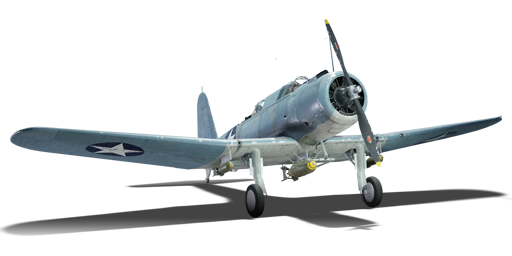



The SB2U was developed in the early 1930s and although considered obsolete at the outbreak of World War II, it still remained in service through the Battle of Midway. However, in 1943, it was withdrawn into training units and replaced by more advanced aircraft. This aircraft featured a constant-speed propeller which was intended to be utilized as a dive brake while performing dive-bombing attack manoeuvres. There are three hard points for bombs to be attached, one 250 lb bomb under each wing and a single 500 or 1,000 lb bomb mounted onto a pylon under the fuselage. The larger bomb was also attached to what was called a "trapeze", a device which would when the bomb was released, swing the bomb clear of the propeller arc.
It was introduced in Update 1.75 "La Résistance". The SB2U-2 is a carrier-based dive bomber. This aircraft is a fairly slow aircraft, but sturdy. Built as a dive-bomber, it excels at diving down above a target to release its bombs. Unlike many dive bombers in War Thunder, the SB2U does not feature dive brakes, instead, its landing flaps can aid in retarding the build-up of speed during a dive, helping prevent ripping off of wings in RB and SB. Wing mounted machine guns allow for this aircraft to strafe softer ground or water targets while waiting for bombs to reload (AB). Rear-facing dorsal gunner helps to ward off enemy attackers, but it isn't a game-changer for this aircraft. However, thanks to its rather low BR, it will face biplanes frequently which can be dealt with using the rear 7.7 mm machine gun.
flaps
flaps
flaps
brake
| Belt | Belt filling | Armor penetration (mm) at a distance: | |||||
|---|---|---|---|---|---|---|---|
| 10 m | 100 m | 500 m | 1000 m | 1500 m | 2000 m | ||
| T/AP/AP-I/Ball/Ball/I | 13 | 12 | 7 | 3 | 2 | 0 | |
| T/AP/AP-I/AP-I/I | 13 | 12 | 7 | 3 | 2 | 0 | |
| IT/AP-I | 13 | 12 | 7 | 3 | 2 | 0 | |
| AP-I/AP-I/I | 13 | 12 | 7 | 3 | 2 | 0 | |
| Belt | Belt filling | Armor penetration (mm) at a distance: | |||||
|---|---|---|---|---|---|---|---|
| 10 m | 100 m | 500 m | 1000 m | 1500 m | 2000 m | ||
| T/AP/AP-I/Ball/Ball/I | 13 | 12 | 7 | 3 | 2 | 0 | |
| T/AP/AP/AP | 13 | 12 | 7 | 3 | 2 | 0 | |
| T/AP-I/AP-I/AP-I | 13 | 12 | 7 | 3 | 2 | 0 | |
2 × 100 lb AN-M30A1 bomb
2 × 250 lb AN-M57 bomb












Flight performance | |
|---|---|
Survivability |
|---|
Weaponry | |
|---|---|